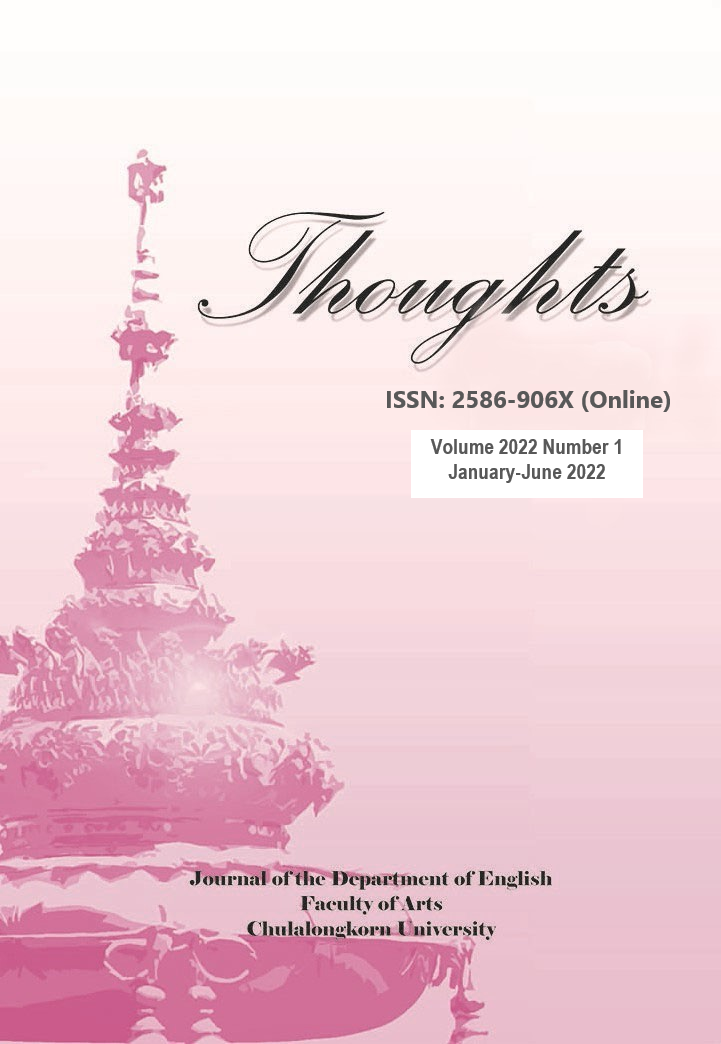Ethics for Survival in Margaret Atwood’s The Year of the Flood
DOI:
https://doi.org/10.58837/CHULA.THTS.2022.1.1Keywords:
Survival, Ethics, The Year of the Flood, Deep Ecology, Margaret AtwoodAbstract
Margaret Atwood’s The Year of the Flood presents a story about ethics and survival in the wake of apocalypse. Environmental ethics is the key factor that allows God’s Gardeners to survive in both the pre- and post-apocalyptic time. The group champions a non-materialistic, self-sufficient lifestyle and a belief in the equal and intrinsic value of all lives. The chance of survival and salvation is credited to the group’s environmental ethic which bears a resemblance to that of the deep ecology philosophy propagated by Arne Naess. Nonetheless, it must be noted that Atwood portrays God’s Gardeners in an equitable manner, despite their commendable belief system, so as to foreground the complexity of the actual application of ethics and call into question the perfectibility of human beings, human society, and ethics itself.
References
Atwood. M. (2013). The year of the flood. Virago Press.
Bahrawi, N. (2013). Hope of a hopeless world: Eco-teleology in Margaret Atwood’s Oryx and Crake and The Year of the Flood. Green Letters, 17(3), 251-263. https://doi.org/10.1080/14688417.2013.862156
Bergthaller, H. (2010). Housebreaking the human animal: Humanism and the problem of sustainability in Margaret Atwood's Oryx and Crake and The Year of the Flood. English Studies, 91(7), 728-743. https://doi.org/10.1080/0013838X.2010.518042
Bouson, J. B. (2011). “We’re using up the earth. It’s almost gone”: A return to the post-apocalyptic future in Margaret Atwood’s The Year of the Flood. Journal of Commonwealth Literature, 46(1), 9-26. https://doi.org/10.1177%2F0021989410395430
Bouson, J. B. (2016). A ‘joke-filled romp’ through end times: Radical environmentalism, deep ecology, and human extinction in Margaret Atwood’s eco-apocalyptic MaddAddam trilogy. Journal of Commonwealth Literature, 51(3), 341-357. https://doi.org/10.1177%2F0021989415573558
Canavan, G. (2012). Hope, but not for us: Ecological science fiction and the end of the world in Margaret Atwood’s Oryx and Crake and The Year of the Flood. Lit: Literature Interpretation Theory, 23(2), 138-159. https://doi.org/10.1080/10436928.2012.676914
Jennings, H. (2010). The comic apocalypse of The Year of the Flood. Margaret Atwood Studies, 3(2), 11-18. https://corescholar.libraries.wright.edu/cgi/viewcontent.cgi?article=1191&context=english
Kuznicki, S. (2017). Margaret Atwood’s dystopian fiction: Fire is being eaten. Cambridge Scholars Publishing.
Lindhe, A. (2015). Restoring the divine within: The inner apocalypse in Margaret Atwood’s The Year of the Flood. In K. Waltonen (Ed.), Margaret Atwood’s apocalypse (pp. 41–56). Cambridge Scholar Publishing.
Mohr, D. M. (2015). Eco-dystopia and biotechnology: Margaret Atwood, Oryx and Crake (2003), The Year of the Flood (2009) and MaddAddam (2013). In E. Voigts & A. Boller (Eds.), Dystopia, science fiction, post-apocalypse: Classic, new tendencies and model interpretations (pp. 283–302). WVT Wissenschaftlicher Verlag Trier.
Naess, A. (2005a). The apron diagram. In A. Drengson (Ed.), The selected works of Arne Naess (pp. 2336–2343). Springer. https://doi.org/10.1007/978-1-4020-4519-6_92
Naess, A. (2005b). The deep ecology movement: Some philosophical aspects. In A. Drengson (Ed.), The selected works of Arne Naess (pp. 2291–2314). Springer. https://doi.org/10.1007/978-1-4020-4519-6_88
Naess, A. (2005c). The shallow and the deep, long-range ecology movement: A summary. In A. Drengson (Ed.), The selected works of Arne Naess (pp. 2263–2269). Springer. https://doi.org/10.1007/978-1-4020-4519-6_85
Northover, R. A. (2016). Ecological apocalypse in Margaret Atwood’s MaddAddam trilogy. Studia Neophilologica, 88(sup 1), 81-95. https://doi.org/10.1080/00393274.2015.1096044
Rowland, L. (2015). Speculative solutions: The development of environmental and ecofeminist discourse in Margaret Atwood’s MaddAddam. Studies in Canadian Literature, 40(2), 46-68.
Schmeink, L. (2016). Biopunk dystopias: Genetic engineering, society and science fiction. Liverpool University Press. https://www.jstor.org/stable/j.ctt1ps33cv
Weafer, M. (2015). Writing from the margin: Victim positions in Atwood’s The Year of the Flood. In K. Waltonen (Ed.), Margaret Atwood’s apocalypse (pp. 57–70). Cambridge Scholars Publishing.
Downloads
Published
Issue
Section
License

This work is licensed under a Creative Commons Attribution-NonCommercial-NoDerivatives 4.0 International License.
Copyright by the Faculty of Arts, Chulalongkorn University.
Photocopying is allowed for internal, non-commercial use only. Photocopying for other uses or for purposes other than indicated must be permitted in writing from the Faculty of Arts, Chulalongkorn University.
All views or conclusion are those of the authors of the articles and not necessarily those of the publisher or the editorial staff.


